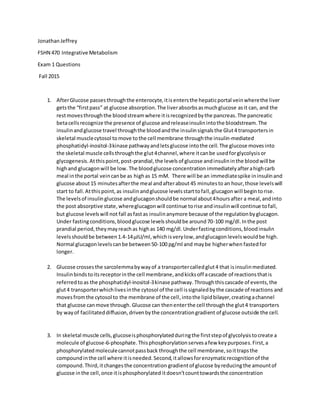
Integrative Metabolism Exam Questions on Glucose Absorption and Metabolism
- 1. JonathanJeffrey FSHN 470 Integrative Metabolism Exam 1 Questions Fall 2015 1. AfterGlucose passesthroughthe enterocyte,itisentersthe hepaticportal veinwherethe liver getsthe “firstpass” at glucose absorption.The liverabsorbsasmuchglucose asit can, and the restmovesthroughthe bloodstreamwhere itisrecognizedbythe pancreas.The pancreatic betacellsrecognize the presence of glucose andreleaseinsulinintothe bloodstream.The insulinandglucose travel throughthe bloodandthe insulinsignalsthe Glut4 transportersin skeletal musclecytosol tomove tothe cell membrane throughthe insulin-mediated phosphatidyl-inositol-3kinase pathwayandletsglucose intothe cell.The glucose movesinto the skeletal muscle cellsthroughthe glut4channel,where itcanbe usedforglycolysisor glycogenesis. Atthispoint, post-prandial, the levelsof glucose andinsulininthe bloodwill be highand glucagonwill be low. The bloodglucose concentration immediatelyafterahighcarb meal inthe portal veincanbe as highas 15 mM. There will be an immediatespike ininsulinand glucose about15 minutesafterthe meal andafterabout45 minutesto an hour,those levelswill start to fall.Atthispoint,as insulinandglucose levelsstarttofall,glucagonwill begintorise. The levelsof insulinglucose andglucagonshouldbe normal about4hoursafter a meal,andinto the post absorptive state,whereglucagonwill continue torise andinsulinwill continue tofall, but glucose levelswill not fall asfastas insulinanymore because of the regulationbyglucagon. Under fastingconditions,bloodglucose levelsshouldbe around70-100 mg/dl.Inthe post prandial period,theymayreachas highas 140 mg/dl.Underfastingconditions,bloodinsulin levelsshouldbe between1.4-14µIU/ml,whichisverylow,andglucagonlevelswouldbe high. Normal glucagonlevelscanbe between50-100 pg/ml and maybe higherwhen fastedfor longer. 2. Glucose crossesthe sarcolemmabywayof a transportercalledglut4 that isinsulinmediated. Insulinbindstoitsreceptorinthe cell membrane,andkicksoff acascade of reactionsthatis referredtoas the phosphatidyl-inositol-3kinase pathway. Throughthiscascade of events,the glut4 transporterwhichlivesinthe cytosol of the cell issignaledbythe cascade of reactions and movesfromthe cytosol to the membrane of the cell,intothe lipidbilayer,creatingachannel that glucose canmove through.Glucose can thenenterthe cell throughthe glut4 transporters by wayof facilitateddiffusion,drivenbythe concentrationgradient of glucose outside the cell. 3. In skeletal muscle cells,glucoseisphosphorylatedduringthe firststepof glycolysistocreate a molecule of glucose-6-phosphate. Thisphosphorylationservesafew keypurposes.First,a phosphorylated moleculecannotpassback throughthe cell membrane,soittrapsthe compoundinthe cell where itisneeded.Second,itallowsforenzymaticrecognitionof the compound.Third,itchangesthe concentration gradientof glucose byreducingthe amountof glucose inthe cell,once itisphosphorylated itdoesn’tcounttowardsthe concentration
- 2. gradientanylongersoit allowsmore glucose toenterthe cell. Thisphosphorylationiscatalyzed by HexokinasesIand II.Theyhave a low Km( ~ .1) and a highaffinityforsubstrate.The phosphorylationof glucose isanendergonicreactionmeaningitrequiresenergytogoforward. Thismeansthe reactionisnot favorable.Inorderto overcome thispositive change infree energy, the reactioniscoupledwiththe hydrolysisof ATPto ADP.The conversionof glucose to G-6-P costs3.3Kcal/mol (endergonic).The hydrolysisof ATPtoADP releases7.3Kcal/mol (exergonic).Bycouplingthesetworeactions,the total change in free energyis –4.0 Kcal/mol. The reactionbecomesexergonicoverallandisable tomove forward. Thisenzyme is allostericallyinhibitedbyhighlevelsof G-6-P.Allostericinhibitionof Phosphofructokinase by highATP levelswouldalsoinhibithexokinase because of the downstreambackupof G-6-P. 4. The keyenzyme inglycogenesisisglycogensynthase.Itcatalyzesthe reactionthatformsa glycosidicbondbetweenactivatedUDP-glucose andterminal glycogenresidue.Glycogen synthase isactive whenitisnot phosphorylated.Insulinaffectsthisenzyme inacouple ways. 1. Throughthe phosphatidyl-inositol-3kinase pathway;Glycogensynthase Kinase 3isan enzyme downstreaminthe P-I-3Kpathwaythat phosphorylatesGlycogenSynthase. When insulinbindsto itsreceptoronthe cell membrane itcausesthe cascade of reactions knownas the PI-3 K pathwaywhichincludes the phosphorylationof GSK-3.GSK-3is inactive when phosphorylated.Thismeansitwill notgoonto phosphorylate glycogensynthase,leaving glycogensynthase initsactive form, andglycogenesiscontinues. 2. The otherway insulinstimulatesglycogensynthase isbyreducingthe amountof cyclicAMP. Wheninsulinisactive,cAMPisnotbeing producedbyadenylate cyclase throughG-protein coupledreceptors.cAMPactivatescAMPdependentproteinkinase (PKA).PKA stimulatesthe phosphorylationof PPI-1,whichdecreasesthe activityof phosphoproteinphosphatase,an enzyme thathelpsdephosphorylate glycogensynthase (active).Soif cAMPreducesthe Active glycogensynthase,andinsulininhibitscAMP,InsulinupregulatesGlycogensynthase. 5. Glycogenolyisisincreasedby the onsetof exercise bythe presence of the hormones epinephrine orglucagon.The keyenzyme inglycogenolysisisglycogenphosphorylase,which removesglucose fromglycogen. WhenglucagonbindstoaG-proteincoupledreceptorinthe cell membrane, the alphasubunitmovesovertoactivate adenylyl cyclase whichcatalyzesthe synthesisof cAMPfromATP.CAMP activatesPKA,which actson phosphorylase kinase,changing it fromitsinactive formtoits phosphorylatedactive form. PKA alsoactson PPI-1,andinhibitor of phosphoproteinphosphorylase(PP),whichremovesthe phosphatefromglycogen phosphorylase.Bydown-regulatingthe activityof PP,more glycogenphosphorylaseremainsin itsactive phosphorylatedstate.Ona side note,PPalsodephosphorylatesGlycogensynthase leavingitinactive.Thisisaperfectexampleof the body avoidingfutilecyclingbyavoiding simultaneousglycogenesisandglycogenolysis.Duringthe onsetof exercise,epinephrine also comesintoplay,due to stimulationof the sympatheticnervoussystem. Andthisalsohasan effectonupregulatingglycogenphosphorylase.When epinephrine bindstoanalpha-1 adrenergicreceptoronthe cell membrane of the myocyte,itstimulatesag proteintoactivate Phospholipase C- gammatohydrolyze phosphatidylinositol-4-5-bisphosphate (PIP2) toinositol 1,4,5 triphosphate (IP3).IP3 acta as a signalingmoleculetothe sarcoplasmicreticulumtorelease calcium.Calciumbindstocalmodulin,whichstimulatesphosphorylase kinasetophosphorylate
- 3. phosphorylase.Alsothe mechanical contractionof the myocyte willresultinextracalciumbeing releasedfromthe sarcoplasmicreticulum.The alphaadrenergicpathwaydescribedaboveisa fastacting pathway,allowingfor fastaccessto storedenergy.Glycolysisisstimulatedbyan increase inglycogenolysisbecauseglycogenolysis resultsinthe conversionof glycogento glucose-1-Pbyglycogenphosphorylase, thenthe conversionof G-6-P,byphosphoglucomutase. G-6-P, is the strongeststimulatorof Phosphofructokinase (PFK),the keyenzyme inglycolysis. Thisrelationshipallowsthe cellstocontinue tocreate energythroughthe glycolyticpathway. Thisthe bloodisnotdepletedof glucose foruse bythe brainandCNS,because inthiscase, insulinwillnotbe active,therefore glut4transporterswill be lessactive, andthe glucose will not be absorbedthe myocytes,andtheirhighaffinityforglucose (Hexokinase1and 2). The compartmentationof glycolysisandglycogenolysishappeninginthe myocyte allowsthe cells to use energytheyproduce intheirowncell,sothere isnoneedto drainthe bloodstreamof glucose.